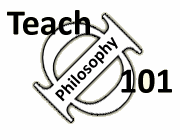Teach Philosophy 101
Free resources for
philosophy teachers!
"One of the most comprehensive, well-researched, and accessible guides for teachers that I have ever seen." James Lang, Chronicle of Higher Education (read full review of TΦ101)
Classroom Assessment Techiques (CATS)
The research suggests that lectures are most effective if they can be interrupted with some active learning exercise. One such approach is to give the students short, ungraded, anonymous quizzes. These exercises are called "Classroom Assessment Techniques" and they serve two purposes. On the one hand, they make the students engage more actively with the material, and, at the same time, they give the instructor a sense of what the students are getting out of the class. Here are some examples:
-
One Sentence Summaries. Students are asked to respond to a specific question that directs their thinking, e.g. "What is Descartes trying to prove with by talking about dreams?"
-
Surveys of Knowledge. Ask students (before topic is covered) what their beliefs about the topic are.
-
Application Cards. Students are asked to write on a card a specific real world application of the theory or concept that has just been discussed in class. This also tests a higher order of thinking than just understanding what is said.
-
Chain notes. The professor passes out several envelopes, each has a question about the class. Students read the question, write a brief answer, and put it in the envelope.
-
One Minute Papers. Here the professor asks students (at the end or middle of the class) to take four or five minutes to write a short paper, saying what is the main point that they learned and what questions they still have. Some students report that knowing that they will be asked to do a one minute paper helps them organize their thoughts during the lecture, and the responses give the teacher a sense of what has been learned.
Techniques using specialized materials:
-
Group quizzes (with scratch-off sheets). We usually think of quizzes as a way to assess individual students but they often work better if assigned to a group. Dan Mittag (Albion College) does these with IF-AT scratch-off sheets available from Epstein Education. The students get a multiple choice answer sheet with scratch off responses and they work together to figure out the best answer. If they scratch off the correct response they see an "*." If their first answer is wrong, they need to decide which is the next best answer. Correct answers on the first try are awarded more points than correct answers on the second or third try (though it is important that some credit can be earned after an initially wrong answer, to motivate continuing to work through the problem). Former TP101 Editors Tarver and Immerwahr can confirm from experience that students love this method and are demonstrably engaged with the material whenever it is used.
-
Clickers/Apps. In large classes, professors use these electronic devices or, more often these days, students' phones, to answer multiple choice questions projected at the front of the class. These can either give the professor feedback to direct the lecture or can be used as the basis of small group discussions. Here is an overview of some of the instructional technologies out there.
-
Polling. Whether or not one uses clickers, student surveys on issues are a great way to build student engagement. For example, a teacher might distribute a survey with some questions about some cases at the beginning of class (asking other students to quickly score and tabulate the results) and then use the results to guide the lecture or discussion. Nadelhoffer and Nahmias have an excellent discussion of this in Teaching Philosophy (31.1 2008: 39-58), including some suggestions and sample cases.
A "Triple-Play" of Easy-to-Remember Acronyms*
-
S-E-E-I (sometimes called the SEEing I) is an exercise where students are asked to go through a four step process with a concept that the teacher has introduced:
-
1) S-tate the concept;
-
2) E-laborate upon it;
-
3) E-xemplify it by providing an example or application;
-
4) I-llustrate it with a map or chart. You can also ask groups of students do do this.
-
-
C.L.I.M.B is a similar task:
-
1) Choose a concept from the class discussion;
-
2) List similarities to a concept from another class;
-
3) Identify differences between the two concepts;
-
4)Make up new examples;
-
5) Build a paragraph demonstrated understanding.
-
-
IDEA is a good exercise for the end of class, and is a variation on the one minute paper strategy:
-
1) Identify a concept from the class;
-
2)Describe why it is important;
-
3) Elaborate on what thoughts or questions the concept brings up;
-
4) Apply the concept to some area of your life.
-
More...
-
Time on Task. Ask students (anonymously) how much time they spent in the last week doing the assignments.
Sources:
"Classroom Assessment Techniques." National Teaching and Learning Forum. 14 February 2008
Classroom Assessment Techniques (CATS). Vanderbilt University Center for Teaching. 22 February 2008
*Sweet, Charlie, Hal Blyth, and Bill Phillips. Triple Play National teaching and Learning Forum 19:2, February 2010, 1-4
Angelo, T.A. and K.P. Cross. Classroom Assessment Techniques: A Handbook for College Teachers. (San Francisco: Jossey-Bass, 1993.
Nadelhoffer, Thomas, Eddy Nahmias, "Polling as Pedagogy: Experimental Philosophy as a Valuable Tool for Teaching Philosophy," Teaching Philosophy 31.1 (2008): 39-58.
Author: John Immerwahr
Update: October 4, 2015 (E. Tarver)
